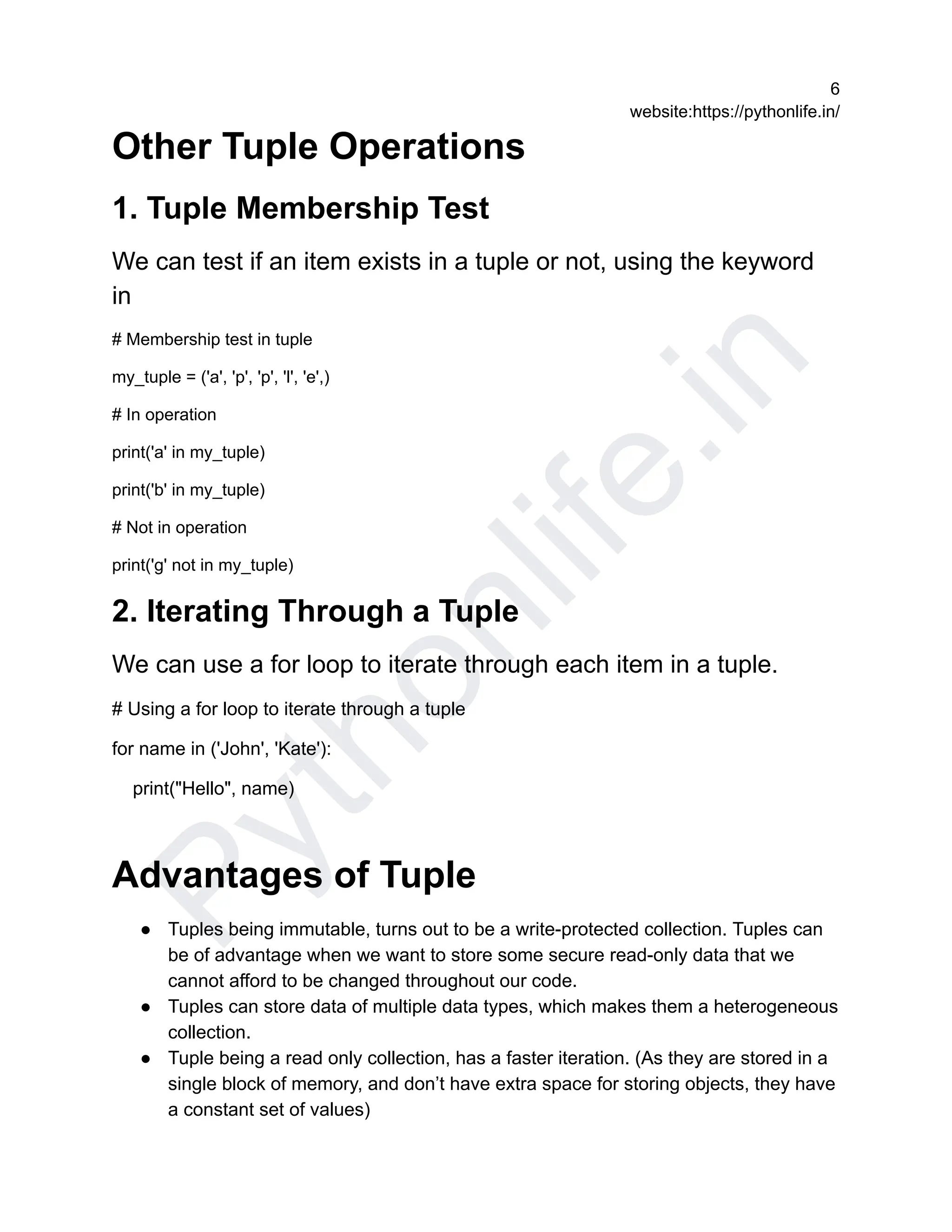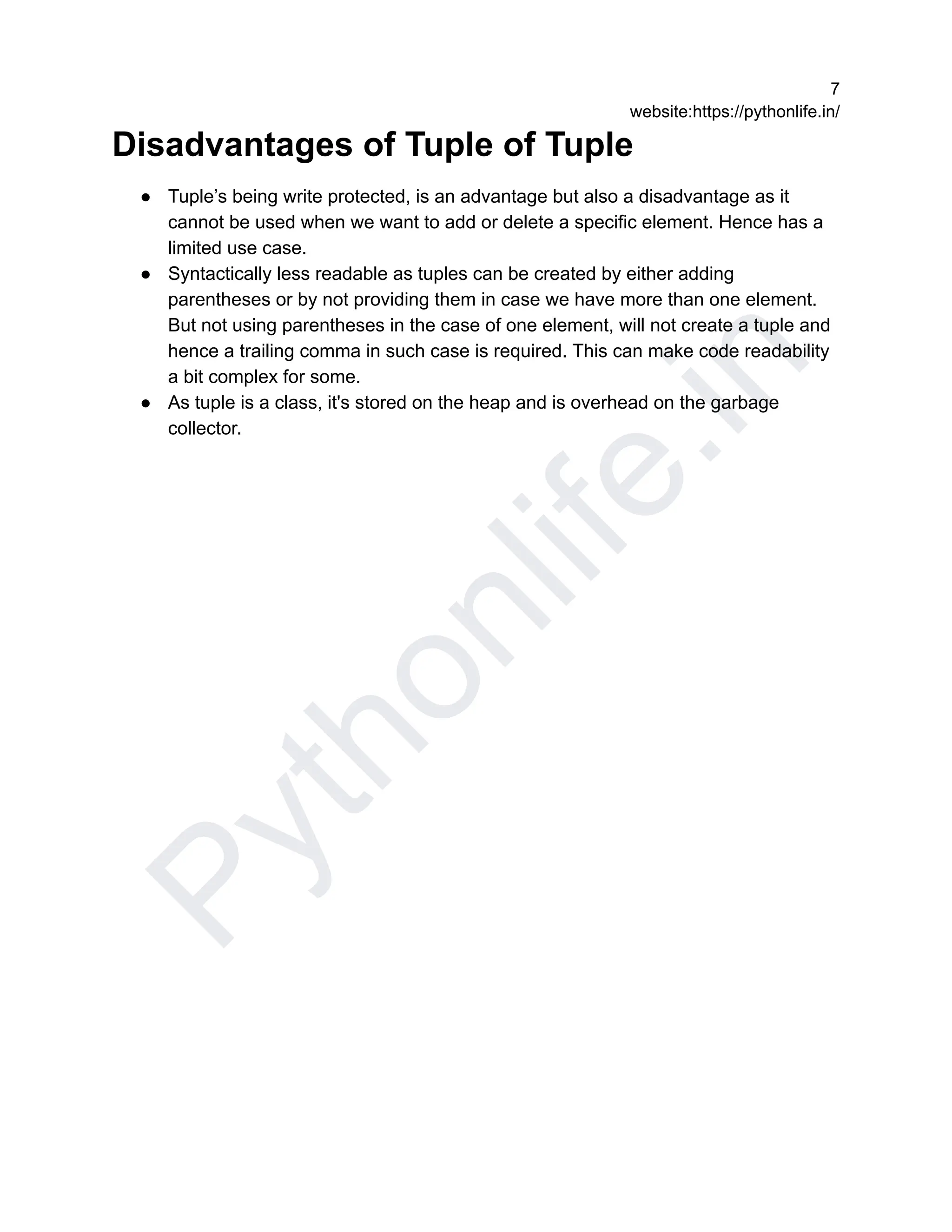The document provides an overview of Python tuples, highlighting their characteristics as immutable sequences created with parentheses. It explains how to create, access, and manipulate tuples, including methods like indexing, negative indexing, slicing, and tuple operations such as concatenation and repetition. Additionally, it discusses the advantages and disadvantages of using tuples in Python, including their efficiency and limitations.
![P
y
t
h
o
n
l
i
f
e
.
i
n
1
website:https://pythonlife.in/
Python Tuple
A tuple in Python is similar to a list. The difference between the two is that
we cannot change the elements of a tuple once it is assigned whereas we
can change the elements of a list.
Creating a Tuple
A tuple is created by placing all the items (elements) inside parentheses(),
separated by commas. The parentheses are optional, however, it is a good
practice to use them.
A tuple can have any number of items and they may be of different types
(integer, float, list, string, etc.).
my_tuple = ()
print(my_tuple)
my_tuple = (1, 2, 3)
print(my_tuple)
my_tuple = (1, "Hello", 3.4)
print(my_tuple)
my_tuple = ("mouse", [8, 4, 6], (1, 2, 3))
print(my_tuple)
Access Tuple Elements
There are various ways in which we can access the elements of a tuple.
1. Indexing
We can use the index operator [ ] to access an item in a tuple, where the index starts
from 0.So, a tuple having 6 elements will have indices from 0 to 5. Trying to access an
index outside of the tuple index range(6,7,... in this example) will raise an IndexError
The index must be an integer, so we cannot use float or other types. This will result in
TypeError.](https://image.slidesharecdn.com/tupleinpython-250129102036-74ca4162/75/Tuple-in-Python-class-documnet-pritened-1-2048.jpg)
![P
y
t
h
o
n
l
i
f
e
.
i
n
2
website:https://pythonlife.in/
Likewise, nested tuples are accessed using nested indexing, as shown in the example
below.
my_tuple = ('p','e','r','m','i','t')
print(my_tuple[0]) # 'p'
print(my_tuple[5]) # 't'
n_tuple = ("mouse", [8, 4, 6], (1, 2, 3))
# nested index
print(n_tuple[0][3]) # 's'
print(n_tuple[1][1]) # 4
2. Negative Indexing
Python allows negative indexing for its sequences.
The index of -1 refers to the last item, -2 to the second last item and so on.
my_tuple = ('p', 'e', 'r', 'm', 'i', 't')
print(my_tuple[-1]) # 't'
print(my_tuple[-6]) # 'p'
In-built Functions for Tuple:
Function Description
cmp(tuple1,tuple2) Compares elements of two different tuples
len(tuple) Returns the length of the tuple
max(tuple) Returns the element with max value from the tuple
min(tuple) Returns the element with min value from the tuple
tuple(seq) Returns a tuple, by converting a list to a tuple. Takes a list in the
parameter](https://image.slidesharecdn.com/tupleinpython-250129102036-74ca4162/75/Tuple-in-Python-class-documnet-pritened-2-2048.jpg)
![P
y
t
h
o
n
l
i
f
e
.
i
n
3
website:https://pythonlife.in/
3. Slicing
We can access a range of items in a tuple by using the slicing operator colon :
my_tuple = ('p','r','o','g','r','a','m','i','z')
print(my_tuple[1:4])
print(my_tuple[:-7])
print(my_tuple[7:])
print(my_tuple[:])
Slicing can be best visualized by considering the index to be between the elements as shown
below. So if we want to access a range, we need the index that will slice the portion from the
tuple.](https://image.slidesharecdn.com/tupleinpython-250129102036-74ca4162/75/Tuple-in-Python-class-documnet-pritened-3-2048.jpg)
![P
y
t
h
o
n
l
i
f
e
.
i
n
4
website:https://pythonlife.in/
Changing a Tuple
Unlike lists, tuples are immutable.
This means that elements of a tuple cannot be changed once they have been assigned.
But, if the element is itself a mutable data type like a list, its nested items can be
changed.
We can also assign a tuple to different values (reassignment).
my_tuple = (4, 2, 3, [6, 5])
my_tuple[3][0] = 9 # Output: (4, 2, 3, [9, 5])
print(my_tuple)
my_tuple = ('p', 'r', 'o', 'g', 'r', 'a', 'm', 'i', 'z')
print(my_tuple)
We can use + operator to combine two tuples. This is called concatenation.
We can also repeat the elements in a tuple for a given number of times using the *
operator.
Both + and * operations result in a new tuple.
# Concatenation
# Output: (1, 2, 3, 4, 5, 6)
print((1, 2, 3) + (4, 5, 6))
# Repeat
# Output: ('Repeat', 'Repeat', 'Repeat')
print(("Repeat",) * 3)](https://image.slidesharecdn.com/tupleinpython-250129102036-74ca4162/75/Tuple-in-Python-class-documnet-pritened-4-2048.jpg)
![P
y
t
h
o
n
l
i
f
e
.
i
n
5
website:https://pythonlife.in/
Deleting a Tuple
As discussed above, we cannot change the elements in a tuple. It means that we
cannot delete or remove items from a tuple.
Deleting a tuple entirely, however, is possible using the keyword del.
# Deleting tuples
my_tuple = ('p', 'r', 'o', 'g', 'r', 'a', 'm', 'i', 'z')
# can't delete items
# TypeError: 'tuple' object doesn't support item deletion
# del my_tuple[3]
# Can delete an entire tuple
del my_tuple
# NameError: name 'my_tuple' is not defined
print(my_tuple)
Tuple Methods
Methods that add items or remove items are not available with
tuple. Only the following two methods are available.
Some examples of Python tuple methods:
my_tuple = ('a', 'p', 'p', 'l', 'e',)
print(my_tuple.count('p')) # Output: 2
print(my_tuple.index('l')) # Output: 3](https://image.slidesharecdn.com/tupleinpython-250129102036-74ca4162/75/Tuple-in-Python-class-documnet-pritened-5-2048.jpg)

